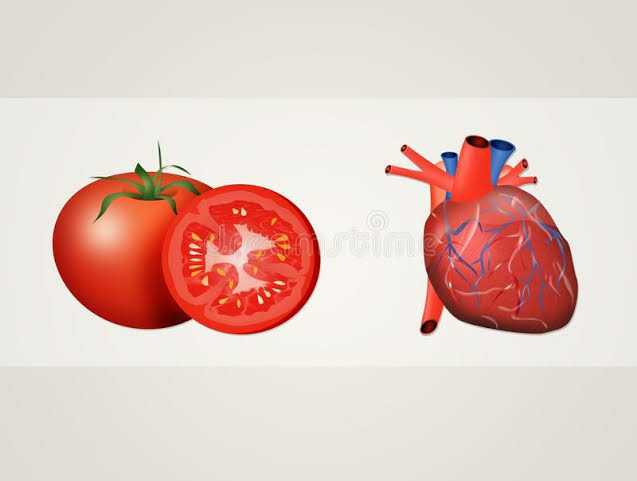Health benefits of tomatoes 🍅
Yoga for acidity or acid reflux
Healthy living: Yoga poses to treat acidity
According to research published in the National Institutes of Health, practising yoga was shown to help regulate and/or alleviate symptoms connected to digestive disorders, such as acid reflux.
Acid reflux or acidity is a prevalent ailment which develops when the stomach generates too much acid. Food breakdown happens typically by the acid caused by the stomach, but occasionally the stomach’s acid production goes overboard, producing an excess of acid.
“Proper chewing of food, drinking enough water, and stopping smoking are essential for those with acid reflux or heartburn; otherwise, it may make the condition worse. Along with a few other naturopathic remedies, yoga may help reduce acidity in the digestive system and effectively treat acid reflux,” said Dr G Prakash, Deputy Chief Medical Officer, Jindal Naturecure Institute.
Studies have indicated that people who experience acid reflux report stress as a key contributing factor to their acid reflux symptoms. According to research published in the National Institutes of Health, practising yoga was shown to help regulate and/or alleviate symptoms connected to digestive disorders, such as acid reflux.
Paschimottanasana, or the Forward bend position,
It is helpful for promoting better function of abdominal organs. Because of its holistic benefits, the pose cures digestive issues like acidity, which are connected to an imbalanced digestive system. This asana also helps in regulating the menstrual cycle and reducing abdominal fat.
Halasana (Plow Pose)
Halasana is known as the plough posture as the phrase “Hala” is Sanskrit for “plough”, and “asana” means “pose” in Sanskrit. It has the ability to increase flexibility, strength, and the spinal muscles as well. It’s an efficient way to relieve tension in the shoulders and back muscles as well.
Vajrasana (Thunderbolt Pose, or Diamond Pose)
This is a fairly easy yoga posture that may be practised either after lunch or dinner. This asana is one of the best for acidity since it improves digestive function, reduces bloating, and helps to alleviate abdominal discomfort. Also known as the “diamond pose,” Vajrasana is a good meditation and breathing posture for cultivating tranquilly.
Pavanamuktasana (Wind-Relieving Pose)
It is another powerful posture for reducing acidity, and as such, is quite useful for healing digestive issues, such as constipation and gas. It also massages the intestines and other organs in the belly and strengthens the lower back and abdominal muscles. It has other benefits, such as improving circulation in the hip joints and easing stress in the lower back.
Ushtrasana (Camel pose)
The practice of Ushtrasana helps to promote digestion by stimulating the abdominal organs. It increases the strength and flexibility in the chest, belly, and neck and also aids in better blood flow to the pelvic area and the brain. In order to allow for better capacity in the lungs and chest, this asana is beneficial. This asana also releases stress from the abdominal area, further treating acidity.
Kapal Bhati Pranayama (Breath of Fire Technique)
This breathing technique generates body heat, which then breaks down waste materials and toxins stored in the body, most especially in the stomach region, thereby lowering acidity. It has the additional benefit of increasing your lung capacity, making them stronger.
Naturopathy tips for healing acidity and gas.
While yoga may be a fantastic cure for stomach and acidity issues, it’s helpful to include some easy dietary modifications and good eating habits to get visible improvement in overall gastrointestinal health.
It is recommended that rather than drinking an ounce of water, drink lots of it. And don’t rely on only water. Instead, drink green tea, fruit juices, lime water, and fruit smoothies, coconut water instead. This will assist you to lower your chances of developing heartburn since it will lessen the acidity in your stomach.
Spicy food is often related to increased acidity. People with acidity have to be extra careful while making meals with red sauce, vinegar, or similar foods since they may do quite some damage. Instead, increase your consumption of fresh fruits and raw vegetables, which have greater water content and nutritional value.
Eating at irregular hours also often leads to acidity. And so, naturopaths also advise eating meals on time and not skipping meals.
Additionally, people should avoid eating too much or too little since these actions may lead to an imbalance in the body. Eating modest portions throughout the day instead of one or two large meals can help ensure that you are getting enough nutrition. Thus, not only is it a beneficial habit to relieve acidity, but also for maintaining a healthy lifestyle overall
SHOULDER PAIN AND EXERCISES
- Shoulder pain is a common problem
- There are many things that can cause shoulder pain
- For most people, it will improve over time with appropriate treatment.
Inflammation of the shoulder capsule
- Synovitis is when your synovial membrane becomes inflamed. It can occur as a result of another condition or it may happen as a result of an injury. Or the cause may be unknown.
- Frozen shoulder is a condition that occurs when your shoulder capsule thickens and becomes inflamed and tight. There may also be less synovial fluid to lubricate the joint. As a result your shoulder becomes difficult to move. Frozen shoulder may occur as a result of another condition (e.g. diabetes), if the shoulder has been immobilised (e.g. due to surgery or injury), or the cause may not be known.
Injuries and sprains
- Ligaments are soft tissues that connect bones to bones. They provide stability to your shoulder by keeping the bones where they’re meant to be. If the ligaments are injured or sprained, they can cause short-term pain. This may be the result of the humerus coming partially out of the joint socket (subluxation) or if the humerus comes completely out (dislocation).
- The flexible tissue that helps keep your shoulder joint in place (the labrum) can become torn. This is called a labral tear. This can occur as a result of an injury (e.g. falling onto your outstretched arm) or repetitive actions (e.g. throwing sports such as cricket).
- A direct blow to your shoulder can result in the acromioclavicular joint being sprained. This type of injury often occurs in people participating in contact sports such as football who take a blow to the shoulder. It can also occur as a result of a fall.
- Rotator cuff: this group of tendons and muscles keep your shoulder stable and positioned correctly for your shoulder and arm to move. Tears to rotator cuff tendons may occur as a result of an injury (e.g. a fall, broken collarbone) or happen over a period of time as you age.
Symptoms of shoulder pain
There are many causes of shoulder pain, and they all have their own unique set of symptoms.
Depending on the cause of your shoulder pain you may experience:
- pain deep in the shoulder joint, in the back or the front of the shoulder and the upper part of the arm. Sometimes the pain in the shoulder can be described as a ‘catching pain’. The location and type of pain is likely to relate to the structure causing the pain
- reduced movement, and pain when moving your shoulder.
- weakness of the shoulder/upper arm. Depending on the condition, there may be a sensation of the joint slipping out and back in to the joint socket, or the shoulder can become completely dislodged (dislocated)
- sensations of pins and needles (tingling) and burning pain. This is more likely to be associated with nerves from the neck than the shoulder joint itself.
- lack of movement after a shoulder dislocation. This is usually due to pain. Complete rotator cuff tears and injury to the axillary nerve both cause weakness in moving the arm away from the body. These problems require close clinical examination.
Symptoms of shoulder pain
There are many causes of shoulder pain, and they all have their own unique set of symptoms.
Depending on the cause of your shoulder pain you may experience:
- pain deep in the shoulder joint, in the back or the front of the shoulder and the upper part of the arm. Sometimes the pain in the shoulder can be described as a ‘catching pain’. The location and type of pain is likely to relate to the structure causing the pain
- reduced movement, and pain when moving your shoulder.
- weakness of the shoulder/upper arm. Depending on the condition, there may be a sensation of the joint slipping out and back in to the joint socket, or the shoulder can become completely dislodged (dislocated)
- sensations of pins and needles (tingling) and burning pain. This is more likely to be associated with nerves from the neck than the shoulder joint itself.
- lack of movement after a shoulder dislocation. This is usually due to pain. Complete rotator cuff tears and injury to the axillary nerve both cause weakness in moving the arm away from the body. These problems require close clinical examination.
Diagnosing shoulder pain
Health practitioners who treat shoulder pain are trained to investigate and identify the exact cause of the condition or injury causing the pain. They will do this by:
- asking about your shoulder pain, including potential causes (e.g. recent injuries, other health conditions), if you have had shoulder pain before, things that make your pain worse, things that make it better
- conducting a thorough physical exam.
From this information they can work out the likelihood of particular structures in the shoulder being involved. Sometimes they will suggest that investigations or tests may be needed.
It’s important to know that many investigations show ‘changes’ to your shoulder that are likely to represent the normal passage of time (even by age 45), not ‘damage’ to your shoulder. An experienced health practitioner can help you to understand the difference.
X-ray
X-rays provide images of your bones and joints. They can show any changes caused by arthritis in the shoulder joint (e.g. bone spurs, narrowed joint space) or fractures. However x-rays don’t show any changes or problems with your soft tissues (e.g. muscles, tendons).
Ultrasound
Ultrasounds are typically used to investigate your rotator cuff tendon for inflammation, tears or rupture. While it can be a helpful tool to use, and can provide clues to identify the source of your pain, a diagnosis can’t be made using the ultrasound alone. If an ultrasound is ordered, then an x-ray should also be arranged. Both tests will provide more complete information about the state of your joints and the tendon.
CT and MRI
Computed tomography (CT) and magnetic resonance imaging (MRI) scans are usually not the first test used to investigate shoulder pain. They may be used when a fracture is suspected or an accident is involved. These scans will help determine the extent of injury and whether further assessment and treatment by a surgeon is needed.
Treating shoulder pain
There are many treatments for shoulder pain:
- physiotherapy – one of the first treatment approaches involves physiotherapy and modifying your activities that make your pain worse. Physiotherapy will aim to fix problems such as stiffness and weakness. It will also include retraining the movements or activities related to your sport, work or everyday activities that were aggravating your shoulder so that wherever possible, you can get back to what you were doing.
- Heat and cold packs – may help provide you with temporary relief of pain and stiffness.
- Medication– such as paracetamol and low dose anti-inflammatories can be helpful in controlling pain while you work to maintain and restore movement and function. If you have high blood pressure or cardiac or kidney disease, you should talk to your doctor before using these medications. Medications shouldn’t be considered as a long-term solution for your shoulder pain. If your pain persists, you should discuss other treatment options with your doctor.
- Self-management
- Most people with shoulder pain will recover from their condition. For many there will need to be a commitment to an exercise-based rehabilitation program. It may also be necessary to make modifications to your lifestyle and work practices that aggravate shoulder pain. Talk with a physiotherapist and occupational therapist for advice.

- Start standing or sitting tall, and place one hand on your lower back, the other hand on the opposite side of your head.
- Pull your head toward your shoulder, looking straight ahead, until you feel a stretch in your neck.
- Hold for at least 30 seconds and then repeat on the other side.
- Start on all fours, with your hands stacked under your shoulders and your knees stacked under your hips. Engage your core and maintain a flat back.
- Place your left hand on the back of your head, so that your elbow points out to the left side. Rest the hand lightly—don't put pressure on your head or neck. This is starting position.
- Slowly rotate your head and shoulder toward your right hand on the floor.
- Then, reverse the motion and rotate to the left and up so your elbow points toward the ceiling. Hold for a few seconds.
- Return to starting position. Continue this movement for 30 seconds, and then repeat on the other side.
- Kneel on your mat with your knees wider than hip-width apart and your feet together behind you.
- Sit back on your heels (as best as you can) and fold forward, resting your belly on your thighs. Extend your arms out in front of you and rest your forehead on the floor. You'll feel this stretch in your shoulders and back, in addition to your hips and glutes.
- Gently press your chest and shoulders toward the ground to deepen the stretch.
- Hold for at least 30 seconds
- Start on all fours with your hands under your shoulders and hips over your knees.
- Reach your right arm underneath and across your body with your palm facing up.
- Bend your left elbow as you gently lean into your right side; you should feel a stretch in the back of your right shoulder.
- Hold for a few seconds then return to the starting position and repeat.
- Lie on your right side with your knees stacked and bent at 90 degrees and your hips bent at 90 degrees. Stack your arms and hands together on the floor, extended out to the right. This is starting position.
- Slowly open up your body, bringing your left arm up and over to your left side, to form a “T” with your arms. In this position, both shoulder blades should be planted on the floor.
- Slowly reverse the movement to return to starting position.
- Do 5-10 reps. Switch sides and repeat.
Damaged Liver ?????? ..Herb that can cure Liver-Blood- And Much More !
Picrorhiza kurroa (Kutki) Picror...

-
Bodybuilding is centered around building your body’s muscles through weightlifting and nutrition. Whether recreational or compet...
-
You’re not alone if you’ve looked in the mirror and wished you were a little bit taller (and wished you were a baller). But your height is a...




















